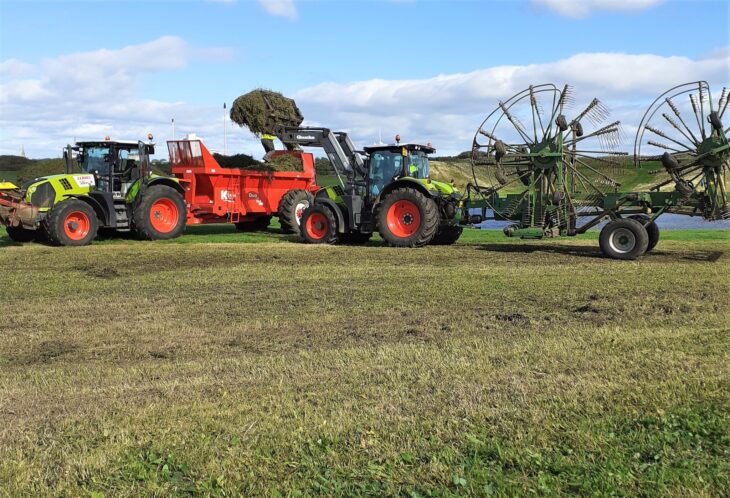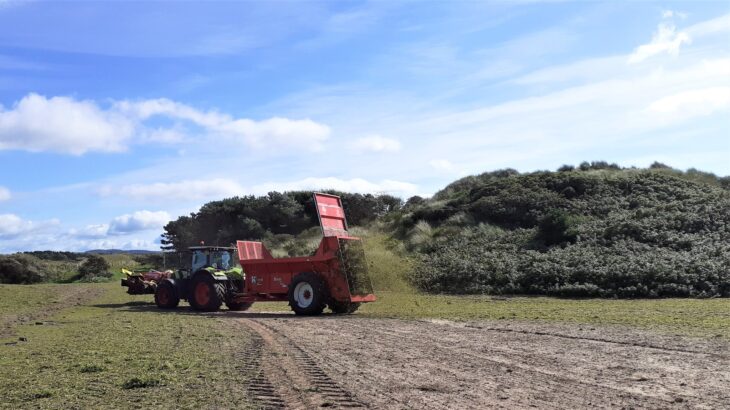Making green hay in North Ayrshire
Since 2020, the Irvine to Girvan Nectar Network has been pioneering the successful use of green hay to transform large scale amenity greenspaces into colourful native wildflower meadows for pollinators. Working with North Ayrshire Council and agriculture contractor Hamish Gilbert, project coordinator Lynne Bates has helped the local authority to cost effectively manage its meadows and create new ones too.

Wildflower meadows only require to be cut once a year, at the end of the growing season, saving local authorities time and money compared to regularly cutting amenity grasslands throughout the summer. The cuttings or arisings from wildflower meadows must be removed to ensure the soil remains infertile for wildflowers to thrive and grass to be less dominant. Cutting and collecting the wildflowers once they’ve gone over, before shedding their seeds, then scattering them over a carefully prepared new site, is an effective way to dispose of the arisings. Otherwise, they would need to be lifted and composted, sent to landfill or left on site somewhere in a pile to decompose. Using the seeds found in the green hay is also a cost saving way to obtain expensive wildflower seeds.

In 2020, 2 wildflower meadows were created at the Beach Park in Irvine, using seeds purchased from Scotia Seeds.
Each year since, more meadows have been created or expanded, trialling the use of green hay and different sowing techniques on a large scale.
To date, 8 hectares of wildflower meadow has been created by the Nectar Network, 5 hectares of which has been created using green hay seed from the original donor meadows at the Beach Park.
Last year, with another 5 meadows being added, including enhancing a site at the Trust’s Oldhall Ponds Wildlife Reserve in Irvine, a total of 14 large meadow sites have been created with 9 of these using seed from a donor site.
Watch the video below or the full playlist on YouTube.
Lynne Bates, project coordinator, said: “We’re grateful that our work with North Ayrshire Council has given us the opportunity to gain the practical knowledge to create and manage large wildflower areas on amenity grasslands and be able to trial different methods for doing this effectively and sustainably. Local authorities are looking to manage their greenspaces for biodiversity as well as cutting carbon emissions. The use of green hay to create wildflower rich sites on a large scale can play a big part in reducing seed costs, cutting carbon and improving greenspaces for people, pollinators, and all wildlife.”
Jim Jeffrey, pollinator strategy manager at NatureScot is delighted that new techniques are being trialled. He said: “The Irvine to Girvan Nectar Network is one of Scotland’s most impressive pollinator-friendly projects. Changing land use and habitat fragmentation are big challenges for pollinators, and the work of the Scottish Wildlife Trust and their partners in Ayrshire to address this problem is fantastic. I’d encourage everyone to have a look at the project as it is full of great ideas and inspiration.”
Find out more about the Irvine to Girvan Nectar Network on their webpage here and on the Scottish Pollinators blog.
Help protect Scotland’s wildlife
Our work to save Scotland’s wildlife is made possible thanks to the generosity of our members and supporters.
Join today from just £3 a month to help protect the species you love.
Preface
Since 2020, the Irvine to Girvan Nectar Network has been pioneering the successful use of green hay to transform large scale amenity greenspaces into colourful native wildflower meadows for pollinators. …
